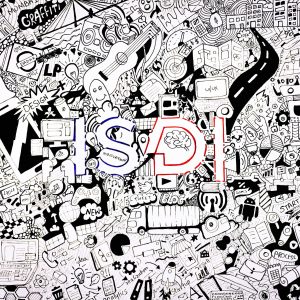What is Design Logo?
A logo is a symbol that helps us identify a brand. It can also help us understand what we like about it. Having a good logo is a vital part of any brand’s identity. A good logo should be able to convey these elements in a compelling and effective manner. But how to design a logo and why is it important?
Importance of a Logo
Makes You Stand Out From the Competition
A logo is very important to make your business stand out from the competition. It can help you differentiate yourself from the other businesses.
Getting a logo is also important if you have competition. Before you get into the logo designing process, you should also research what your competitors’ look like.
Identifies Key Information About Your Business
A good logo not only helps you attract potential customers, but it also provides valuable information about your company to your customers.
Logos can use various elements to communicate your company’s message and thus the logo design process is quite extensive and the logo design rules must be followed to avoid any mishap or extra reworks. Some examples of these include: circuit imagery to represent the software industry, a stylish font to highlight their luxurious goods, or a heart-shaped image to represent romance novels.
Builds Brand Recognition
A logo can also help keep people focused on your brand by providing a visual connection to it. This visual impact can help customers keep their attention on your brand.
It’s no surprise that logos are so important to many brands, such as McDonald’s and Nike. They can be easily recognized and instantly associated with a brand. Hence, now you know what logo design is and its vitalness in the market.
The 7 Step Logo Design Process
-
Discover
Although different designers may have their own approach to this process, most agree that it’s essential that a designer start with a discovery phase and develop a brand strategy. This process involves getting to know the client’s business, competitors, and audience. It’s also about developing a strategy that’s based on the client’s history and needs.
A logo should also serve a specific purpose, so it should be very objective in order to create something that’s appropriate.
A logo is the cornerstone of all brand communication, so it should be able to endure. We don’t want to redesign it in the future, so we should try to create something that will last.
Before you start the logo design process with the tools in the Illustrator, it’s important that you first brief the client.
During the discovery phase, different designers will go through different stages. Some will send a branding questionnaire, while others will have a more informal conversation.
Try using your own brand strategy framework as guidance through the various stages of the logo design process. During this time, going through various branding exercises to extract all the necessary details is the crucial logo design rule.
-
Research
To learn logo design doing extensive research is the seed that gives you result. Doing thorough research helps understand the industry and its environment. It allows you to draw useful conclusions and make informed decisions.
Understanding the various factors that can help a company differentiate itself from its competitors is very important. This can be done through a customer’s perspective.
Doing a thorough analysis of the industry and its competitors is also a crucial step in the logo design process. It will allow you to avoid making a mistake and come up with something unique.
During the strategy session, start by doing a competitive analysis on your client. After that, gather additional information to carry out further research.
Through this process, you gain valuable insight into the various aspects of the competitors’ websites. Then take notes on their strengths and weaknesses so that they can draw useful conclusions.
-
Brainstorm
After conducting a comprehensive research and coming up with a strategy for creating logo ideas, then start brainstorming. This step serves as the first step in the journey to develop a brand identity that will convey your client’s message.
Using voice exercises and the tone of voice exercises, can then start brainstorming ideas and creating moodboards. Also use a mind map to visualize the most important keywords from previous steps.
After coming up with a strategy, I then create three mood boards that are mainly composed of visuals that capture the essence of the strategy.
Before we start working on a logo, we first need to identify the various elements that will represent our brand strategy. Then, we can discuss possible solutions and come up with a direction that will best fit our needs.
-
Sketch
Sketching logos is where creativity comes from. However, since you do your homework, You can easily judge your work against predefined guidelines.
The goal of sketch is to connect an idea to the creation of a form. Most professional designers start by hand.
This method allows you to immediately visualize your ideas and create a visual representation of them. It also allows you to decide on the type of treatment that will best suit the client’s brand. For instance, if the client’s name is Medihuanna, then we will go with a wordmark.
While you’re focused on other tasks, such as driving a car or exercising, your unconscious mind comes up with great ideas.
Having a break can give you a fresh start and a renewed enthusiasm. It can also help you avoid making the same mistakes that plagued you in the past.
We also decided that a symbol should act as a visual shorthand so that it can be used in small sizes. This method is also beneficial for developing ideas.
Since this step usually takes a few days, it’s usually recommended that designers carry something that they can sketch on. Having multiple ideas will allow you to pick a few strong ones and then execute them digitally.
-
Design
Once you have a huge amount of sketches, then you can judge their potential against the strategy and pick the most promising ideas to execute them digitally.
Instead of rushing to create every logo idea that you have, focus on the concepts that can work well for your client.
Before you start working on a project, it’s important that you have a lot of criteria in mind so that you can pick the best possible ideas for your client.The best is to always go back to the basics of how to design a logo for a brand?
After you have a few strong logo ideas, it’s time to start creating vector graphics using Adobe Illustrator. This is one of the tools that allows you to quickly create multiple variations of each idea, if you are a beginner.
The design part of the project can take a long time to complete, especially if it involves testing different colors, fonts, and alignments. It’s also important to tweak the designs to make them look great.
This step is about experimenting with various options in order to get the best possible results. Doing so will help you improve and develop stronger logo concepts.
-
Present
After you have finished designing the logo concepts, show them to the client in a presentation.
Make sure that the solutions that you show are designed to work for the client.
The three logo concepts that you show are the result of a disciplined but creative process. They all revolve around the client’s strategy.
For instance, select a few applications that will be useful to the client in order to show them how the logo will look in real life.
How do you know which kind of mockups to create? List all the marketing initiatives that your client is interested in.
The next step in the logo design process is to test the ideas that you came up with. This will allow you to get a better idea of what the client wants.
To test the viability of the logo concepts, create stunning mockups that will show the client how they will look in real life.
If the presentation is accurate, then the client should be impressed by it. Sometimes, they might be skeptical about the new logo concepts. However, once it’s officially adopted, it can still have a meaningful meaning.
Before the final approval is granted, you might want to tweak a few elements to make sure that the final design is consistent with the client’s expectations.
-
Delivery
Once your client approves the brand identity package, it’s time to deliver it. The package should include logo artwork and a style guide.
In general, make sure to include a basic version of the logo, such as black, white, and full color. You should also save these files for different uses.
Before you start working on the brand identity, make sure to inform the client about the various commercial fonts that are used in the logo. You also need to create a style guide that shows how to use the various variations.
Before you start working on the brand identity, make sure to inform the client about the various commercial fonts that are used in the logo. You also need to create a style guide that shows how to use the various variations.
The style guide should also include other elements such as the photography style, the color scheme, and the various illustrations. You can also customize it according to the client’s needs.
Remember to always deliver on time. When working on logo files, remember to always deliver an extra logo animation.
Final Verdict
Great logos are created through a combination of strategic thinking, experimentation, and failure. Every aspect of your logo should influence people’s perception of your brand. It’s also important to stay focused on your concepts and develop a solid strategic understanding.








